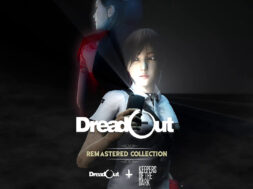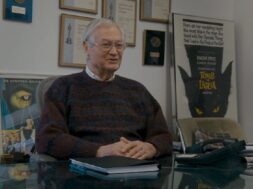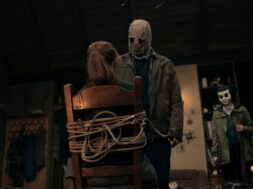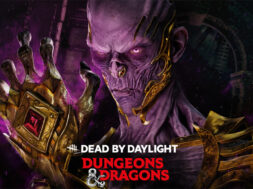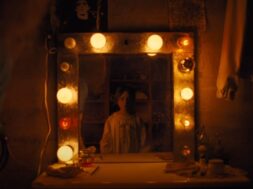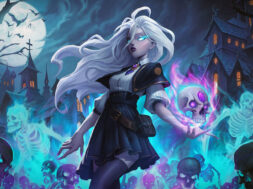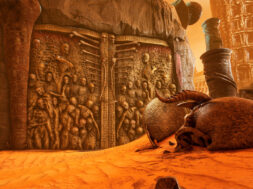With multiple seasons, a spin-off cartoon, and endless merchandise tie-ins under its belt, anthology series Tales from the Crypt decided to parlay its success to the big screen in the mid-90s. Unlike the series, which was based on the 1950s EC Comics of the same name, the first film told an original story unrelated to the horror comics. Book-ended by the series’ beloved Cryptkeeper, a master of undead puns and storytelling, Demon Knight offered a central tale of good versus evil of biblical proportions.
A tongue-in-cheek action-horror hybrid that boasted great practical creature work and a stellar cast from top to bottom, Demon Knight released in theaters on January 13, 1995, just as the sixth season of the series was winding down on HBO. Twenty-five years later, Demon Knight holds up well and remains a standout of ‘90s horror.
Former NYU film school students and pals Ethan Reiff, Cyrus Voris, and Mark Bishop collaborated on the screenplay for Demon Knight in 1987, long before HBO began its seven-season run of Tales from the Crypt. They remained with the script in its many iterations in the long road to production in 1994. Before it finally found its home with Tales from the Crypt, Tom Holland felt it’d make a great follow-up project to Child’s Play, with Chris Sarandon in the villain’s role and Tommy Lee Jones as the hero for Holland’s dream casting.
When the project fell through, director Mary Lambert was the next prominent horror director to show interest. Her vision would’ve drastically changed the story, which entailed making the Demon Knights enslaved people, and her dream casting would’ve had Willem Dafoe as the villain and Edward Furlong as Uncle Willy. The financial failure of Pet Sematary II meant financial backing for her vision of Demon Knight evaporated. The script even passed through Charles Band’s Full Moon Productions for a brief stint, but finally found its way onto the desks at Joel Silver’s Silver Productions, who were looking for a script to round out their package of three Tales from the Crypt features.
Next came director Ernest Dickerson (Bones, The Walking Dead), a lifelong horror fan who’d been searching for a genre project to tackle. Unlike those who came before, Dickerson was a fan of the script, though he did work with Reiff, Voris, and Bishop to refine it. The mythology behind the demons, as well as the character work, were fleshed out further. So too, were the kills and the method in which the demons had to be killed; taking a page from Alien, Dickerson wanted these demons to have an extra level of difficulty to slay. Shooting their eyes, therefore, wasn’t such a simple task anymore. Most of all, though, Dickerson infused the script with his love of Ray Harryhausen. The scene that sees the Collector (Billy Zane) birth demons from hell is an homage to Jason and the Argonauts.

The group wrote two scripts with budgetary limitations in mind — one with monstrous demons, and the other with a more human-like take on demons. The Collector, who was initially called Travelling Salesman, would be a bible salesman and fellow traveling salesman would be his legion. Only the removal of their sunglasses that exposed their demonic eyes would indicate they weren’t human. The Demon Knight novelization by Randall Boyll, written from an earlier draft of the script, features the Salesman and numerous changes to the characters and their deaths.
Luckily, Universal Pictures realized the need for actual demons in a movie called Demon Knight and granted extra funding, much to the relief of special effects makeup designer and creator Todd Masters (Tales from the Crypt series, Slither). The stellar designs and work by Masters and his special makeup effects and creature crew contribute a large part of what makes the film so memorable. The unique and intricate designs, and the gore, of course. Masters and some of his crew watched Dead Alive (aka Braindead) during production and fell so hard for it that they brought one of the more outlandish deaths into Demon Knight; The Collector’s fist going straight through Sheriff Tupper’s (John Schuck) head. As for the creature performers, they had the tough task of being enclosed in the monster suits and perform on stilts- to keep balance on the stilts, the performers kept in constant motion.

Well executed creature and gore work, great direction, and a tight script were pushed over the top by a fantastic cast giving it their all. From Zane’s scene-stealing turn as the Collector opposite William Sadler’s grizzled hero Brayker and Jada Pinkett Smith‘s fierce Jeryline to supporting characters like Dick Miller’s Uncle Willy or CCH Pounder’s tough-as-nails Irene, there’s not a single character or actor involved that’s not compelling. Everyone’s a necessary and robust player in one of horror’s best ensembles. They were having a blast making this film, and it’s infectious to see on screen.
The Tales from the Crypt film trilogy never panned out according to the original plan. The film teased in the post-credit scene, Dead Easy, never came to fruition. Nor did Body Count. Producers even considered From Dusk till Dawn and The Frighteners as Tales from the Crypt features, but ultimately went with Bordello of Blood, a screenplay penned by series’ producers Gilbert Adler and A.L. Katz. Love it or hate it, the film had an arduous task of following on the heels of Demon Knight.
Every single facet of Demon Knight’s production is perfection; the soundtrack, the cast, the crew, the creatures, the direction, and the screenplay all work in unison to deliver one seriously entertaining entry in pulp horror. Full of endlessly quotable lines of dialogue, too. Twenty-five years later, anyone involved with the film reflects fondly of their experience working on it, which is a significant testament to its enduring longevity.
Demon Knight is an all-time great. Fangs for the memories, ghouls.

